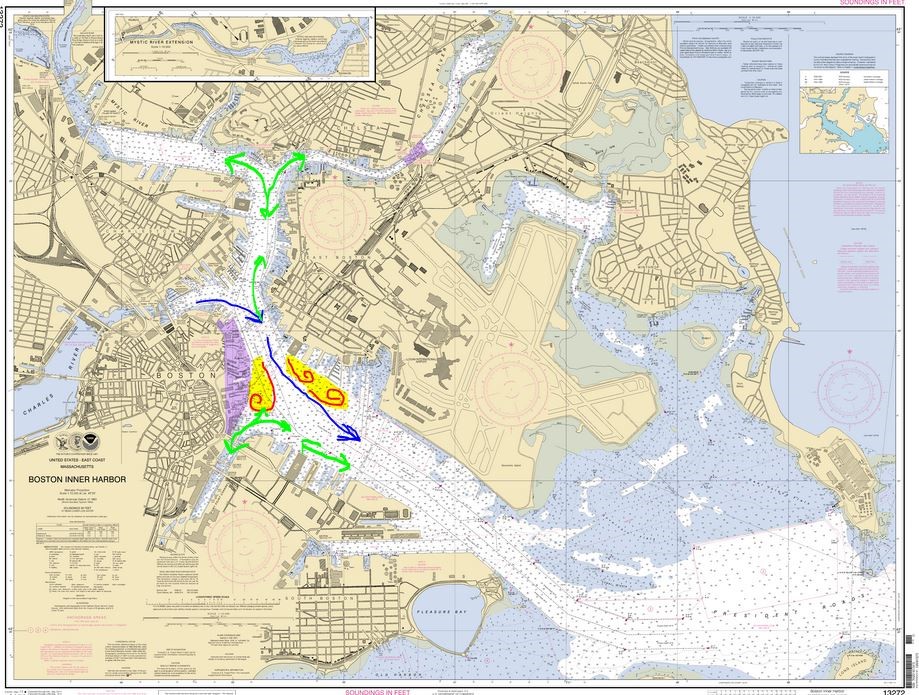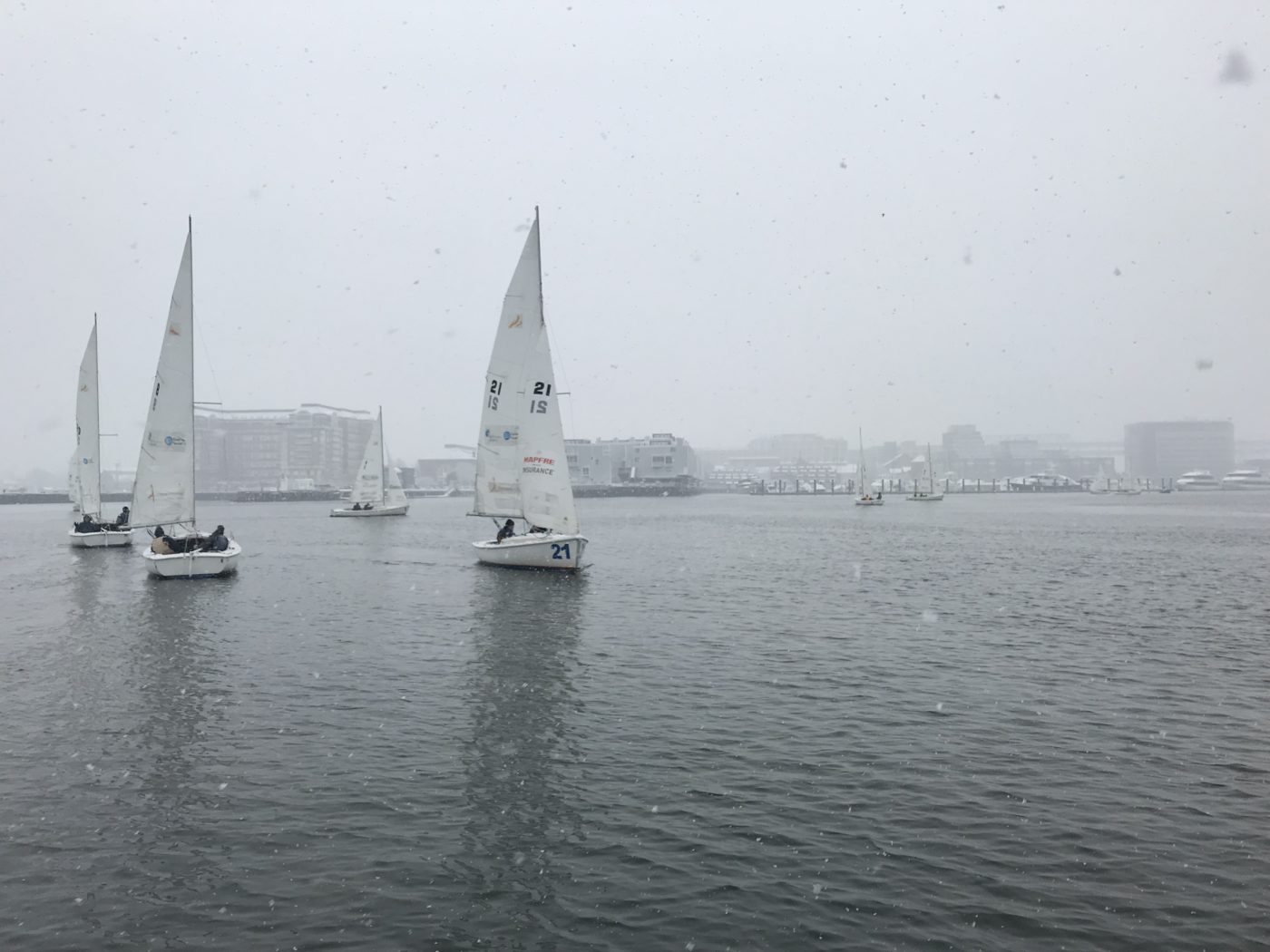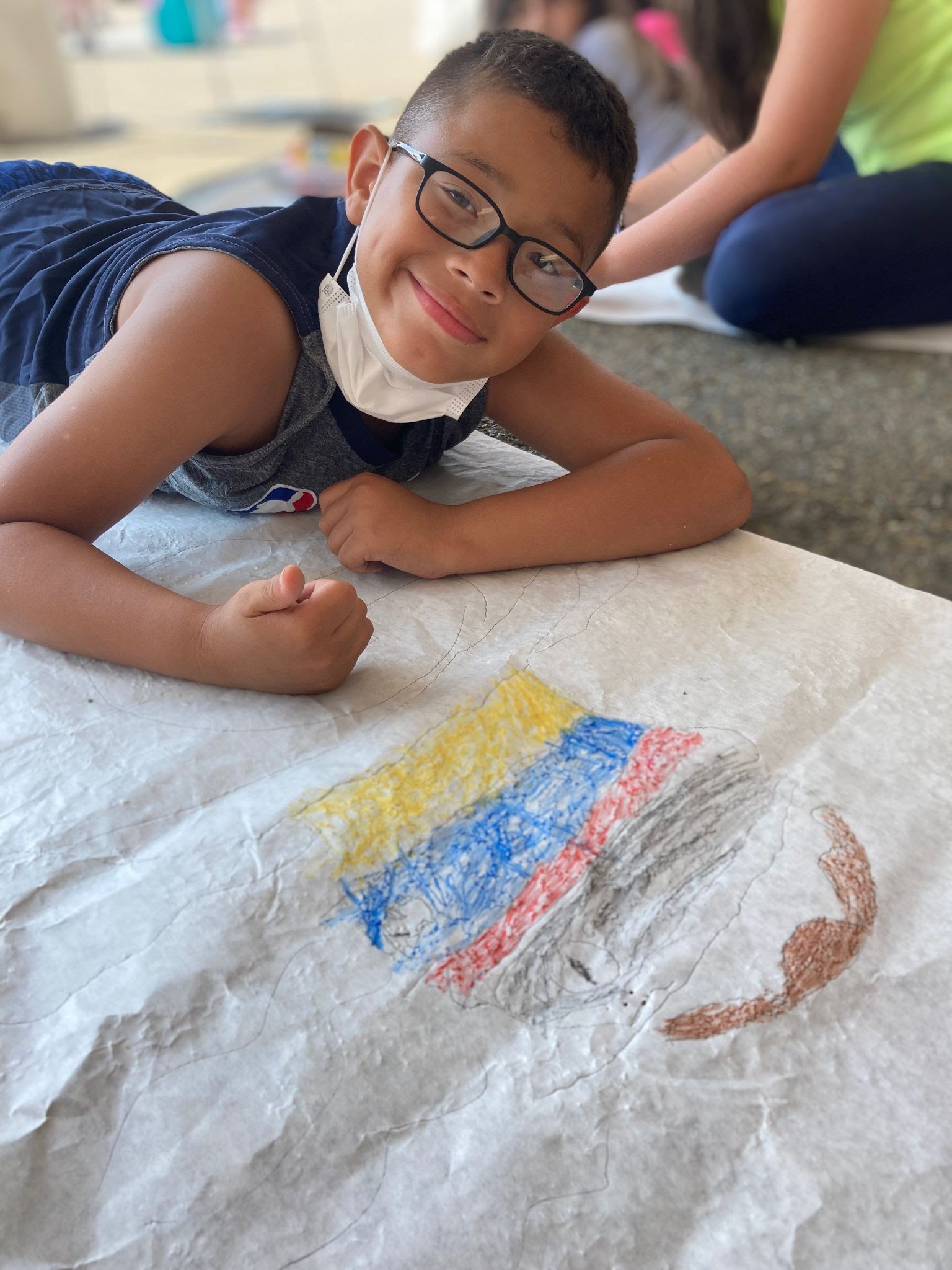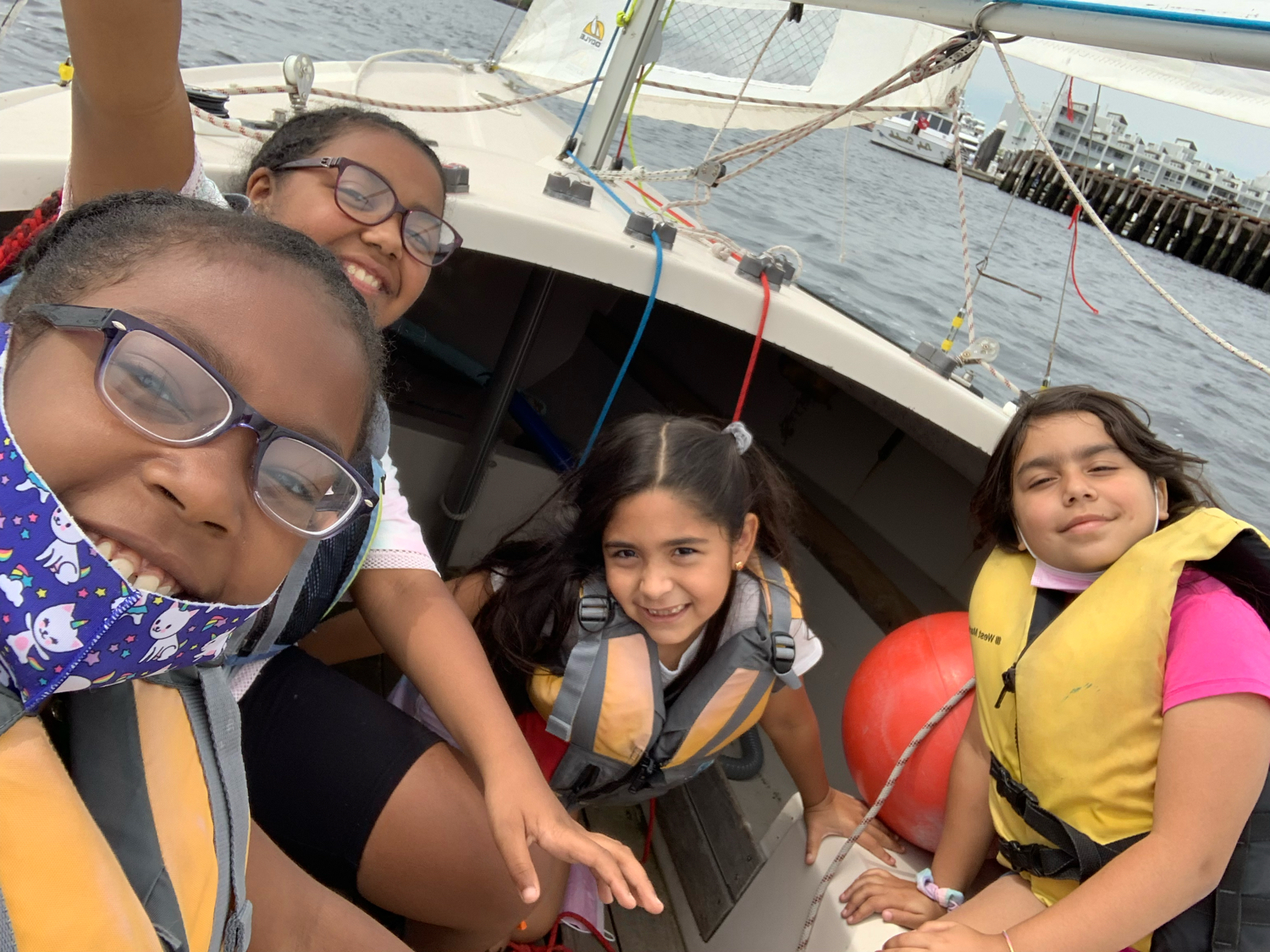Snow, shifty breeze, freezing rain, no visibility, swirling currents and tankers were just a few of the challenges faced on Day 4. In the days leading up to Saturday, no one could agree just how much snow we'd be getting. Forecasts varied from one to seven inches, with periods of freezing rain. It was going to be messy. But that didn't stop the thirty-eight brave souls who ignored the mental health diagnoses from their friends and loved ones, and went sailing instead. As the fleet began to arrive, big, fat, wet flakes started to fall. Temperature was hovering right at 32 degrees, and from that point on it was either wet heavy snow, or stinging freezing rain. That was not the problem however.
The rest of the day would see wind speeds anywhere between 5 and 11 knots from the NNE. The course was set with the RC boat very close to the edge of the channel by the Eddy Building in East Boston, and windward marks close to Charlestown marina and pier 8. Usually during Frostbiting, the race course is farther out, in the vicinity of the Nantucket. But because of the light wind, limited visibility, and wet cold conditions, the course was set closer to home. With low tide being at 930, by the time the races started we were at max flow. A strong current was running from left to right across the line.
During the start of the second race, a harbor ferry and a tugboat were coming through the course. The two Courageous safety boats were able to make a lane for them to pass along the Charlestown side. However, because of this they were not able to replace the leeward gate before the first boats were headed downwind. So the course had no gate. In the event that there is no gate, boats should use the pin as the leeward mark, rounding to port. And that is exactly what they did. It was Mark Lindsay and Jaimie Chicoine who took the bullet for race 2, and who also managed to keep their boat practically snow-free all day. Matt Marston and Cheney Brand were close behind again, for another second place finish.
Congrats to our top 5 finishers on the day...
I asked Niko to share his thoughts on the day, and he very kindly responded with a great piece on the day, and racing in general. I've included them at the end of the recap. Please take the time to read it, it's well worth it. There's a ton of helpful information from beginning to end. In the meantime, thanks again to everyone who showed up despite a terrible forecast, and somewhat miserable conditions. We were the only sailboats on the harbor that day, and we'll do it all over again next week. Please try and come to Pier 6 after racing next week. We will have food and prizes for the top 3 finishers for the "fall" series. You can check here for all the current scores and standings.
-Nate and the Courageous Frostbiting Team
And now as promised, here are Niko's thoughts....
Prep work & jib adjustments:
- Boat was fairly clean, and we wiped off two or three woolly green spots which the team last week missed
- Main halyard, outhaul, and backstay were just snug, and vang with and inch of play
- thermos of hot cocoa
- several pairs ski gloves -> change out as they soak through and easily pull off to untie knots/tangles
- juuuuuust get scallops out w jib halyard
- loosened it on the last run to try to put a little depth in the sail, and then snugged it back up between races
- moved our cars forward one hole early (2nd from front / 3rd from back) to force us to keep the jib eased & not pinch in the light wind (more below)
- We moved the car back one spot for the third and fourth races as the breeze picked up, and we could trim both sails tighter and point higher
- be on the start line... the fleet was really far back, partially because of the current
- Avoid Charlestown shore where we felt breeze was spotty
- While there were some pretty big shifts, we didn't think we could see them coming or predict them, so we just tried to react as they arrived by tacking on headers
- One time in race two, I really pinched to stay in a lift that I COULD see that wasn't filtering to the right half of the course. While the guys with better roundings (ahead of me) did even better in this lift, we gained a ton on the boats below and behind us
- Current is a huge factor any time we are sailing near East Boston, whether in the river convergence or outside in the harbor (see last paragraph)
- find the correct gate (and know when there's no gate) as you could make big gains on each of the three gates by going to the one that was up-current or upwind
Speed:
- first two races, we had the jib eased more than normal, with the jib car forward, causing a low/fast lane
- main eased slightly to allow leech telltales to flow 90% of the time
- adust jib trim to each shift, as I couldn't steer to them quickly enough (overtrim in header, ease in lift) then work back towards regular trim
- communicate any change in jib trim, steering, breeze direction, etc. just each person narrating what they're doing so the other isn't caught by surprise
- backwind the jib slightly during the tacks, and don't ever let the jib luff (and "rolltack" as much as the R19 allows)
- My crew has little experience, and always thought I was pinching badly for several seconds before he realized we were tacking. This demonstrates a) that I need to communicate better, and b) that I coast a TON on the early part of my tack, gaining me lots of distance to windward (only in flat water)
- downwind we did very little winging, as we didn't have the pressure most of the day. A good backstay tell-tale helps a ton with downwind angle. We were able to wing during the biggest puffs of each race, but only after we had waited to pick up speed.
Lot of thoughts on current here. Because fresh water floats on salt water, the current in estuaries often flows out even when the tide is flooding. This is even more true as we approach high tide typically, and for the Charles, during the first half of flood tide because they actively pump that river most days between low and mid (or higher) tides. It's very rare that the current where we sail is actually coming in in the channel, though there are areas near East Boston and the edges of the course that you can find eddies curling back up-current. The current is even more crucial in light wind, as it's a bigger percentage of your speed.
The 1st race, we knew the current was going left to right both because the committee boat was pointing towards the pin (rather than into the wind) and because we could go CB-Pin much slower than we could Pin-CB. From this, we assumed the fleet would get compressed towards the committee boat, leaving the pin less crowded. Also, we wanted to start towards the pin to be up-current, and spend less time fighting it on starboard, and more time with it on port. We weren't sure if this current assist would help us with the windward mark layline so far up the mystic, and indeed, current was more neutral up thjere.
By the time the tanker passed, the current had switched, and the breeze had slid right, as evidenced by the committee boat pointing just to the right of the breeze. This was pushing people away from the boat (towards the pin) and also back from the line, making the fleet late. We were head and shoulders ahead of most at the start, and Nate says we still had a bit of room. Also of note, a hole opened behind us at the boat due to the current, and the top two finishers were in this, and tacked out early. This early tack got Mark and Matt into a good shift/puff on the right, but also towards the shallower water's edge, where the adverse current was less, if not eddying favorably.
By race three, and into race four, the Mystic was ebbing strongly, pushing boats back from the line, and also making the boat end of the line favored because it was up-current. Lastly, this current set boats who thought they were on the layline, making it hard to fetch the windward mark. Also, as the current strengthened, parallel to the wind direction, it decreased the apparent wind, which was most noticeable if we tried to wing on a righty downwind. We found we could easily reach on port or starboard until we got a puff from the left (charlestown) and then wing easily in that pressure which was oblique to the current direction.
Lastly, I highly recommend doing some drawings of your own of what happens when the current and winds change. This is typically a geometry exercise, with laylines and ladder rungs shifting, leeway growing, and different effects on apparent wind and speed over land depending on your board. I leave you with a diagram (attached) I drew a couple years ago with my best guesses at current in the harbor.
Cheers, Niko






